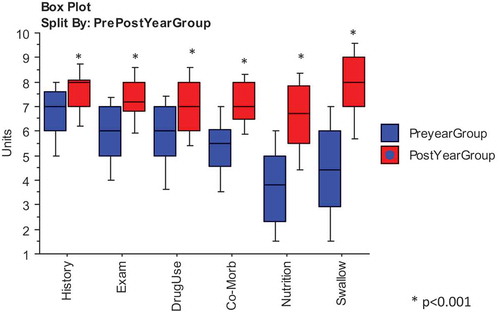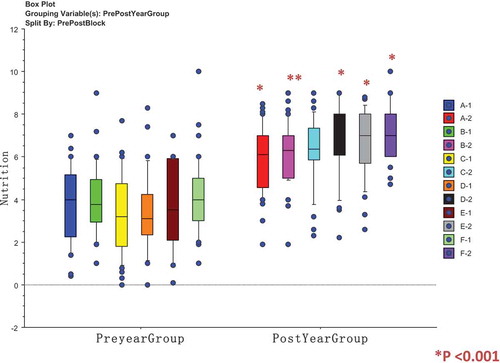Figures & data
Figure 1. The Visual Analogue Scale.
The Visual Analogue scale (VAS) is a graphic scale in which the respondent places a mark at a point along a line, with endpoints of 1 and 10 [Citation8], with 1 representing very little knowledge/skills and 10 representing very good knowledge/skills. The VAS tool was completed for 6 domains in the A&H curriculum
![Figure 1. The Visual Analogue Scale.The Visual Analogue scale (VAS) is a graphic scale in which the respondent places a mark at a point along a line, with endpoints of 1 and 10 [Citation8], with 1 representing very little knowledge/skills and 10 representing very good knowledge/skills. The VAS tool was completed for 6 domains in the A&H curriculum](/cms/asset/adfa7fd2-143d-4dc0-8ab7-b1456d90ba50/zmeo_a_1579558_f0001_oc.jpg)
Table 1. Focus group semi-structured questions.
Table 2. Comparison of Visual Analogue Scale scores for pre- and post- self-perceived assessment of learning needs for total student year group for six clinical domains.
Figure 2. Comparisons visual analogue scores for total year student year pre- and post-scores for self-perceived assessment of learning needs.
Box plots for comparison of pre- and post-Visual Analogue Scale (VAS) responses for self-perceived Assessment of Learning Needs in each of six curriculum domains in Ageing and Health, for the total student Year, showing medians and 25% and 75% values.Analysis by Mann–Whitney U; P values <0.001 considered significant.*Significant differences between Pre-and Post-measurements for each curriculum domain.

Table 3. Comparison of pre- and post-Visual Analogue Scale (VAS) scores for student groups A-D for six domains of the curriculum.
Figure 3. Comparisons of Visual Analogue Scale scores for student group A, B, C, D, E, and F showing pre- and post-VAS scores for self-perceived learning needs for nutrition.
Box plots for comparison of pre- and post-Visual Analogue Scale (VAS) responses for self-perceived Assessment of Learning Needs in each of six curriculum domains in Ageing and Health, showing medians and 25% and 75% values; Analysis by Mann–Whitney U; P values <0.001 significant; Pre-groups are A-1, B-1, C-1, D-1, E-1 and F-1; Post – Groups are A-2, B-2, C-2, D-2, E-2 and F-2.

Figure 4. Four themes with sub-themes emerging from the focus groups discussions about student self-assessment of learning needs.
The four themes are: 1] Identifying Current Learning Needs; 2] Future Use in Identifying Learning Needs; 3] Student-Led Suggestions in VAS Use; 4] Learning Environment Issues in Use of VAS; 5] Self-Regulation in Learning.
![Figure 4. Four themes with sub-themes emerging from the focus groups discussions about student self-assessment of learning needs.The four themes are: 1] Identifying Current Learning Needs; 2] Future Use in Identifying Learning Needs; 3] Student-Led Suggestions in VAS Use; 4] Learning Environment Issues in Use of VAS; 5] Self-Regulation in Learning.](/cms/asset/3ea860d1-338e-47c2-9e40-f0de4f84b1ff/zmeo_a_1579558_f0004_oc.jpg)
